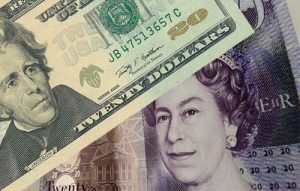 Yesterdays trade saw GBP/USD within the range of 1.4837-1.4990. The pair closed at 1.4952, up 0.07% on a daily basis and extending gains from Friday.
Yesterdays trade saw GBP/USD within the range of 1.4837-1.4990. The pair closed at 1.4952, up 0.07% on a daily basis and extending gains from Friday.
At 8:37 GMT today GBP/USD was up 0.03% for the day to trade at 1.4959. The pair touched a daily high at 1.4974 during early Asian trade.
Fundamentals
United Kingdom
Consumer Inflation
The annual rate of inflation in the United Kingdom probably continued to slow down in February, reaching 0.1%, according to the median estimate by experts, from 0.3% in January. If so, this would be the 14th consecutive month, when annualized consumer prices remained below the 2-percent objective, set by the Bank of England. In addition, it would be the lowest inflation rate on record.
In January cost of transport marked the largest decrease, or 2.8% year-on-year, followed by prices food and non-alcoholic beverages (-2.5%) and miscellaneous goods and services (-0.4%). Prices of recreation and culture went down 0.1% year-on-year during the month. On the other hand, cost of education rose 10% in January, prices of alcoholic beverages and tobacco rose 3.3%, while prices of clothing and footwear were up 1.4%, according to the report by the Office for National Statistics.
The CPI is the main measure of inflation in the UK for macroeconomic purposes and forms the basis of the inflation target set by the government. Every month about 120 000 samples are made, examining the change in prices of about 650 products. They represent the “market basket” of goods and services, on which the index is based.
Key categories in the consumer price index are Transport (accounting for 16.2% of the total weight) and Housing, Water, Electricity, Gas and Other fuels with a 14.4% share. Recreation and Culture accounts for 13.4%, Restaurants and Hotels – 11.4% and Food and Non-alcoholic Beverages – 11.2%. The CPI also encompasses Miscellaneous Goods and Services (9.6%), Clothing and Footwear (6.5%), Furniture, Household Equipment and Maintenance (6.1%). Alcoholic Beverages and Tobacco, Health, Communication and Education comprise the remaining 11.2% of the total weight.
The annualized core consumer price inflation probably slipped to 1.3% in February from 1.4% during the previous month. If so, this would mark the eighth consecutive month, during which annual core inflation stood below the 2% target set by the Bank of England. The core CPI measures the change in prices of goods and services purchased by consumers, without taking into account volatile components such as food, energy products, alcohol and tobacco.
In case the annual CPI slowed down more than expected, thus, further distancing from the central banks inflation objective, this would certainly reduce the appeal of the sterling. The Office for National Statistics (ONS) will publish the official CPI report at 9:30 GMT.
United States
Consumer Inflation
The annualized consumer inflation in the United States probably remained steady at -0.1% in February, according to market expectations. This has been the lowest rate since October 2009, when an inflation of -0.2% was reported. In December 2014 the annual inflation rate was at 0.8%. In monthly terms, the Consumer Price Index (CPI) probably rose 0.2% in February, following three consecutive months of declines. In January compared to December 2014 the CPI slumped 0.7%.
In January energy prices plunged 19.6% year-on-year, as prices of gasoline marked the most significant decrease (35.4% year-on-year). Additional downward pressure came from utility gas service (-0.4%), used cars and trucks (-4.0%), and apparel (-1.4%). Upward pressure came mostly from prices of food, which went up at an annualized rate of 3.2% during the same month, according to the report by the Bureau of Labor Statistics.
The CPI is based on a basket of goods and services bought and used by consumers on a daily basis. In the United States the Bureau of Labor Statistics (BLS) surveys the prices of 80 000 consumer items in order to calculate the index. The latter reflects prices of commonly purchased items by primarily urban households, which represent about 87% of the US population. The Bureau processes price data from 23 000 retail and service businesses.
The CPI includes sales taxes, but excludes income taxes, costs of investments such as stocks and bonds and sales prices of homes.
The annualized core consumer inflation, which is stripped of prices of food and energy, probably remained steady at 1.6% for a third straight month in February. This has been the lowest annual core inflation since February 2014. It is usually reported as a seasonally adjusted figure, because consumer patterns are widely fluctuating in dependence on the time of the year. The Core CPI is a key measure, because this is the gauge, which the Federal Reserve Bank takes into account in order to adjust its monetary policy. The Fed uses the core CPI, because prices of food, oil and gas are highly volatile, while the central bank’s tools are slow-acting. In case, for example, prices of gas surge considerably, this could lead to a high rate of inflation, but the central bank will not take action until this increase affects prices of other goods and services.
If the CPI tends to distance from the inflation objective, set by the Federal Reserve and considered as providing price stability, or below but close to 2%, this will usually reduce the appeal of the US dollar.
The Bureau of Labor Statistics is to release the official CPI report at 12:30 GMT.
Manufacturing PMI – preliminary reading
Manufacturing activity in the United States probably slowed down a bit in March, with the corresponding preliminary Purchasing Managers Index coming in at a reading of 54.7. In February the final seasonally adjusted PMI stood at 55.1, or an improvement from a preliminary reading of 54.3. Output and new orders increased sharply and delays in the delivery of items contributed to an accumulation of backlogs of work and a surge in finished goods stocks.
According to Markits statement: “Manufacturing production growth quickened to the sharpest in four months during February, with firms linking higher output to increases in new business. This was highlighted by a marked rise in total new orders. As with production, the rate of growth in new business was the fastest since last October.
Meanwhile, new export orders continued to rise, albeit only modestly. Higher new orders was one factor leading to an accumulation of backlogs of work in February, while supplier delivery delays had also contributed to rising outstanding business. Delivery times lengthened to the greatest extent since February 2014, with firms reporting adverse weather conditions in some parts of the country. Meanwhile, stocks of finished goods increased at the sharpest pace since the series began.”
Values above the key level of 50.0 indicate optimism (expanding activity). In case the flash manufacturing PMI slowed down more than anticipated, this would have a certain bearish effect on the US dollar. The preliminary data by Markit Economics is due out at 13:45 GMT.
Pivot Points
According to Binary Tribune’s daily analysis, the central pivot point for the pair is at 1.4926. In case GBP/USD manages to breach the first resistance level at 1.5016, it will probably continue up to test 1.5079. In case the second key resistance is broken, the pair will probably attempt to advance to 1.5169.
If GBP/USD manages to breach the first key support at 1.4863, it will probably continue to slide and test 1.4773. With this second key support broken, the movement to the downside will probably continue to 1.4710.
The mid-Pivot levels for Monday are as follows: M1 – 1.4742, M2 – 1.4818, M3 – 1.4895, M4 – 1.4971, M5 – 1.5048, M6 – 1.5124.
In weekly terms, the central pivot point is at 1.4911. The three key resistance levels are as follows: R1 – 1.5189, R2 – 1.5428, R3 – 1.5706. The three key support levels are: S1 – 1.4672, S2 – 1.4394, S3 – 1.4155.





